Tangkoko: A Wallacean Wonderland
First published in Sanctuary Asia,
Vol. 40
No. 8,
August 2020
Text by Mita Dutta, Photographs by Pinak Dutta
I was more than looking forward to my visit to Tangkoko. Apart from being a nature reserve that belonged to the biogeographical sub-region of Wallacea – the biological transition zone between Asian and Australian fauna – it is home to three volcanoes – Mt. Tangkoko, the parasitic ash cone of Batuangus and the twin peaks of Duasudara… all dormant.
The Tangkoko-Duasudara Nature Reserve is the largest intact rainforest in Minahasa, the northernmost regency on the Indonesian island of Sulawesi. The Wallace Line (designated by Alfred Russel Wallace, the Father of evolutionary biogeography in 1859) that runs through Indonesia between Bali and Lombok, and between Borneo and Sulawesi, makes the area conducive to a spectacular mix of biodiversity, some uniquely evolved on account of complete isolation. The rolling hills and forested valleys of the reserve are inhabited by at least 127 mammal, 233 bird and 104 reptile and amphibian species, of which a majority are endemic to the island. Some of the species are particularly threatened due to habitat loss and fragmentation. This includes the black-crested macaque of which about 5,500 remain on the island, spectral tarsier, Sulawesi bear cuscus, Sulawesi dwarf cuscus, and birds such as the Knobbed Hornbill, Sulawesi Hornbill and Maleo. Tangkoko is also an important habitat for fruit bats. The Sulawesi island has 22 recorded species, including many rare and peculiar forms. The two commonly seen species are the Sulawesi rousette and lesser dog-faced fruit bat.
The History of Tangkoko
In 1919, the first conservation area was established at Mount Tangkoko. In 1978, the Duasudara area was included, and later in 1981, Batuangus and Batuputih were included too; the total area of the reserve is now 8,890 ha. Local and tourist visits are restricted only to the Batuputih region of the reserve. Between 1978 and 1993, habitat destruction and incessant hunting took a toll on wildlife in the forests around the volcano. As a result, the black-crested macaque population fell by approximately 75 per cent, and so did that of the endemic bird Maleo Macrocephalon maleo and the bear cuscus, falling by as much as 90 and 95 per cent respectively.
Into the Forest
The entrance to the park is through a quaint fishing village by the sea called Batuputih. The main occupation for people is, not surprisingly, fishing and fish trading. What is surprising is that except for those involved as guides in the nature reserve and locals running homestays, few others seem to be aware of the biodiverse cornucopia they live in.
The October noon sky was overcast when we reached ‘Tangkoko Hill’, our home in Batuputih, close to the reserve’s entrance. A heavy shower followed as we enjoyed our lunch of fried local fish, chicken in traditional sweet soya sauce, batter-fried tofu with rice and fresh juicy papaya as dessert. It had rained in Tangkoko after two entirely dry months. Once the rain abated, as advised by our tour guide, we set out on our excursion armed with our camera, binoculars, water and torch. Our local guide was Mary (a man) from the Batuputih village. We drove to the entrance and then began the trek. Though it was steadily drizzling by now, not a drop penetrated through the thick forest canopy.
_1597406602.jpg)
Located at the northeastern tip of Indonesia’s Sulawesi island, the Tangkoko- Duasudara Nature Reserve spans 8,700 ha. of evergreen rainforest, largely comprising Palaquium genus trees.
The densely-clustered trees made for a sultry environment below, with not so much as a whiff of a breeze. We identified several fig trees, the giver of plenty to wildlife that feasted on their fruits containing high sugar levels and many essential nutrients. Fan palms with large leaves and sharp spines were also dominant in the forest.
Occasional sightings of avian life kept us engaged even as Mary guided us off the gravel road and into a path carpeted with dry leaves. Dry branches snapped as we attempted to navigate forcibly through the thicket. Suddenly, Mary pointed up a tall tree to a ball of fur. It was a bear cuscus, he said, but it was so high up, we could hardly make out its features despite peering through our binoculars. We moved on and soon found another one close enough for a better look. A strange-looking animal, the Sulawesi bear cuscus Ailurops ursinus is in fact not a bear, despite its name, but an arboreal marsupial with thick, wooly bear-like fur. It resides in the upper canopies of the forest and its round, protruding eyes resemble those of a lemur. Its long, prehensile tail along with its sharp curved claws are useful for the folivore to maneuver through the thick trees of the rainforest, enabling it to feed on leaves, seeds, flowers and fruits. Staring at an animal of Australian origin while standing on Asian soil, that is the marvel of Wallacea. It is hypothesised that A. ursinus’ morphological divergence from the rest of the family Phalangeridae can be attributed to its isolation on Sulawesi island when the island first emerged in the Miocene (23.03 to 5.333 million years ago).
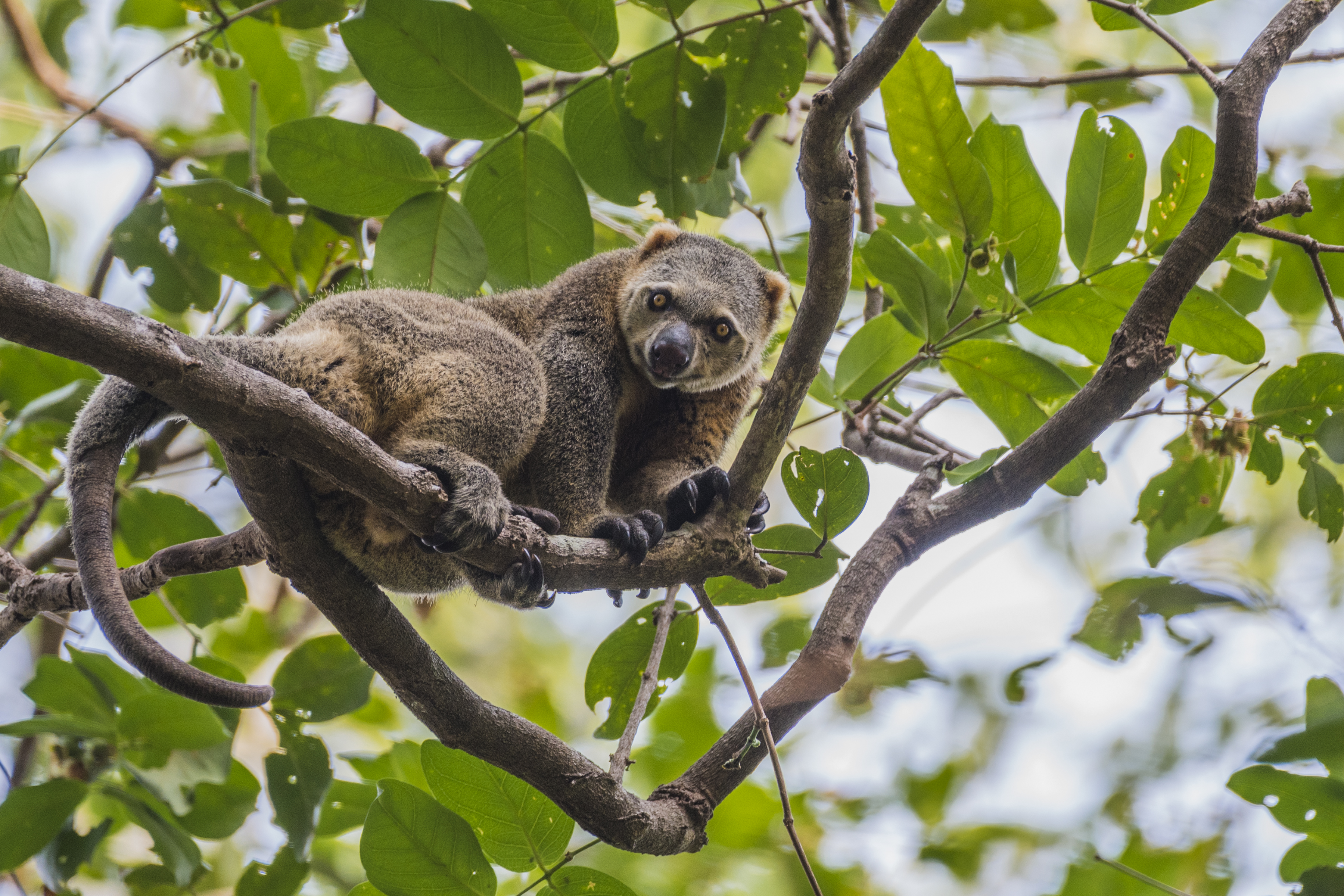
The Sulawesi bear cuscus is not a bear, but an arboreal marsupial. A slow climber, its elongated claws and long, prehensile tail help it cautiously navigate tree canopies.
Between Macaques and Birds
We moved through the thicket, struggling to keep up with Mary. The undulating terrain with thick vegetation was not easy to navigate and eventually, we had to stop to catch our breath in a relatively clear and plain patch of land. A commotion up in the trees caught our attention. A group of noisy, black-crested macaques Macaca nigra sat up in the trees – all of them staring down at us. It was debatable who was feeling more insecure – the macaques, to see their home being trespassed by inquisitive humans, or we who had strayed into their living space. A large, dominant male nerved himself to climb down the branches to take a closer look at us and we were soon surrounded by a group of 20 or so macaques. The romping young ones and the foraging adults, however, made it a point to maintain a distance from us. Both parties gradually grew accustomed to each other’s company.
The macaques were entirely pitch black except for their hind parts, called ischial callosities (sitting pads). The adult females had an inflated red behind (sexual swelling), which resembled red balloons. The macaques seemed to be foraging at a frantic speed, not bothering to chew. “They possess what are called cheek pouches,” explained Mary, “that allows them to cram their food while foraging and then methodically extract them to savour later.” Known locally as yaki, black-crested macaques are one of seven distinct macaque species that evolved on Sulawesi. Aside from loss of forest habitat, extensive killing due to human-animal conflict and for bushmeat by the ethnic Minahasan communities has greatly reduced their number, which has reportedly dropped more than 80 per cent in the last four decades. Surveys from 2009 to 2010 put yaki numbers at about 2,000 and now, due to conservation efforts, it has steadily risen to about 5,500.
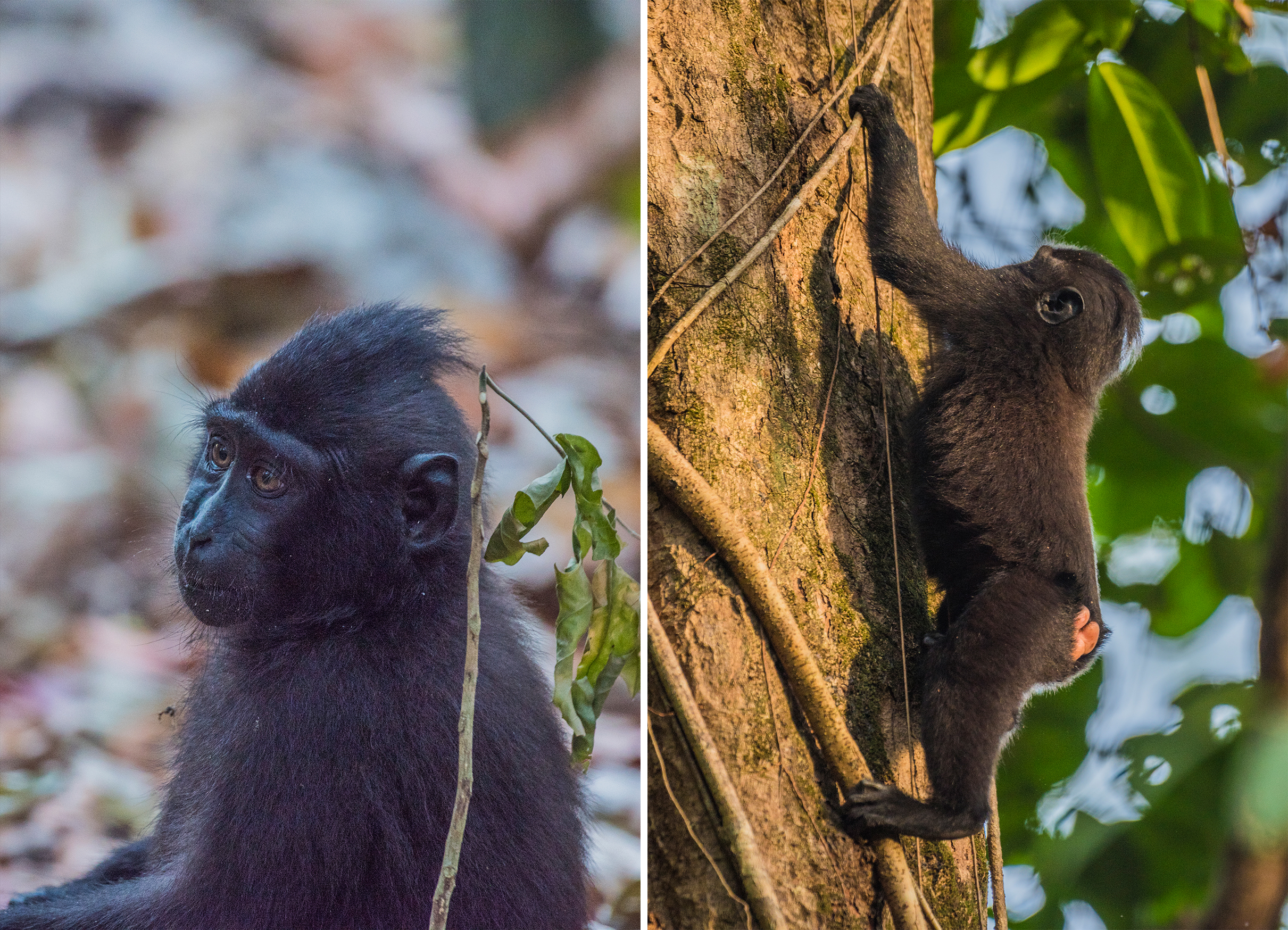
Known locally as yaki, black-crested macaques are one of seven distinct macaque species that evolved on Sulawesi.
We were engrossed watching the family of macaques when we suddenly heard a whooshing sound accompanied by a deep booming call resonating through the forest. We looked up to see the most conspicuous and spectacular bird of Tangkoko – the Red-knobbed Hornbill, also known as the Sulawesi Wrinkled Hornbill. It had landed on a long horizontal branch of a tall tree. It was their nesting season and the spectacular male with buffy brown neck and head and an enormous red casque on top of its bill had returned with food for the nursing female and her young ones, who were hidden inside a tree cavity. Exhibiting a unique reproductive behaviour, as their eggs are a favourite food of monitor lizards, mother Redknobbed Hornbills narrow the entryway to their nests using their feces as sealant. What a visual delight… watching the magnificent bird caring for its family. It was dusk and our necks, strained from looking up at the breathtaking beauty, finally found relief when the enormous bird decided to fly away, its large wings resounding with a whooshing sound. We had already enjoyed the company of three of the four ‘big ones’ of Tangkoko.
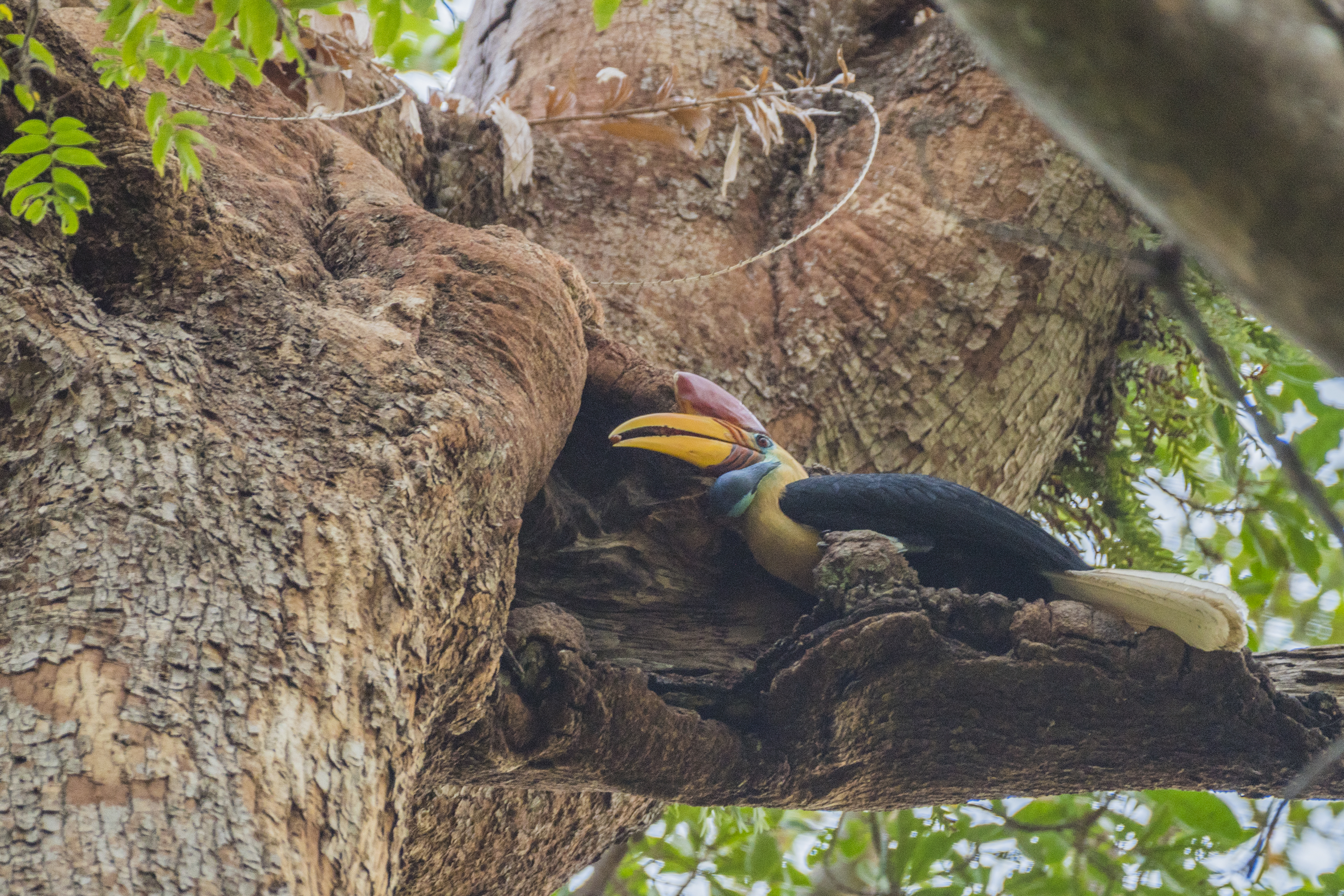
Considered the ‘faunal symbol’ of the South Sulawesi province, the Red-knobbed Hornbill Aceros cassidix is endemic to Indonesia and has been observed moving in flocks of as many as 50 birds.
In Search of the Spectral Tarsier
As the sunlight faded, our excitement escalated. It was time to look for the most coveted sighting of Tangkoko, the spectral tarsier Tarsius tarsier. These nocturnal animals, endemic to Sulawesi, are one of the smallest primates of the world. Mary scanned the forest for these creatures and picked up a vocal duet. Given the darkness, he had to rely on his hearing and years of experience to track down the source. We stopped in front of a tree trunk strangled by hanging roots. Mary’s torch beam navigating the darkness finally flashed across a pair of enormous eyes – a spectral tarsier stared back at us. A tiny animal around 10 cm. in length, its huge eyes and ears alone were visible through the lacework of roots and branches. Soon another inquisitive one, even smaller, probably an infant, joined him. These small animals had tails much longer than their bodies. The tail is mostly naked except for the terminal part, which has a tuft of hair. As we approached them, they quickly vanished, moving in a zigzag motion at lightning speed. Standing in the total darkness, now, we were still able to sense their movement around us. We were again treated to a good sighting of them clinging to a tree trunk. They had sleek long fingers with human-like nails that are particularly long on the second and third digit of their legs. These were toilet claws used for grooming. We were completely bowled over by these tiny creatures that can only be described as ‘weirdly cute’.
The Most Popular Mammal of Tangkoko
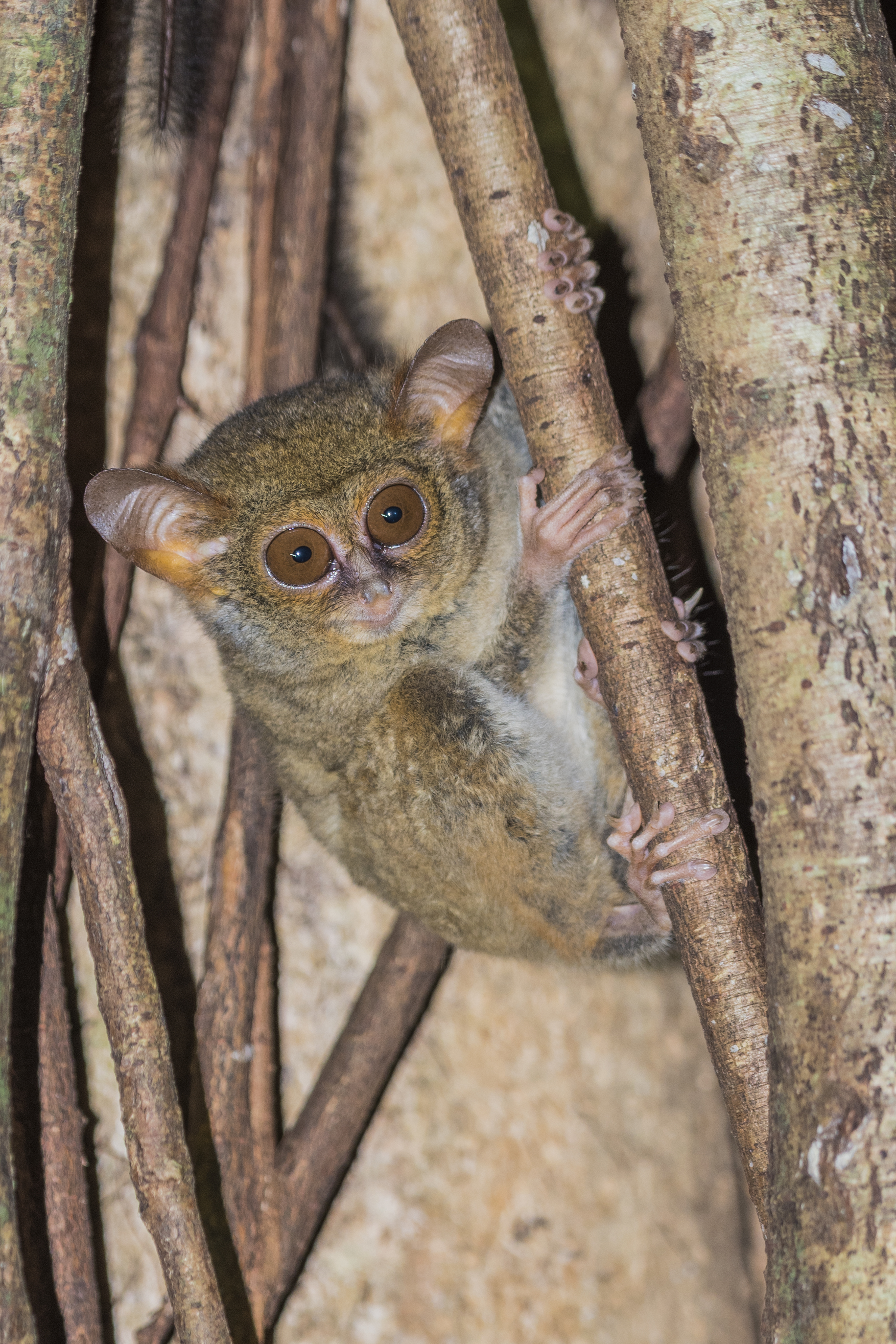
The tarsier is a species of small leaping primates found on various islands of Southeast Asia, belonging to the 45-million-year-old family Tarsiidae. The tarsiers of Southeast Asia are among the smallest – they measure between nine and 16 cm. long, with long tails about twice that length. They are quite unusual in appearance – resembling an intermediate form of lemurs and monkeys. Their most striking features are their large goggling eyes, measuring typically 1.5 cm., which are an evolutionary tactic for nocturnal survival due to their lack of a tapetum lucidum, a reflective layer behind the retina that nocturnal animals usually possess. The name tarsier is eponymous of their elongated tarsal region, in which their tibia and fibula bones are fused; this greatly enhances their leaping ability – they can jump 40 times their body length in a single leap! Tarsiers are currently divided into three genera and 11 species. The genus Tarsius, with nine species, is restricted to Sulawesi and nearby small islands of Indonesia. The other two tarsier genera are at present monotypic; one is from Philippines and the other from Borneo, Sumatra and nearby small islands. The spectral tarsier Tarsius spectrum residing in Tangkoko is a nocturnal, carnivorous predator that hunts for insects like katylids (long-horned grasshoppers), roaches and crickets using their highly sensitive eyes, mobile ears and grasping hands. They live in social groups made up of a mating pair and their offspring, usually inside the dark hollows of trees. Tarsiers are one of the most vulnerable victims of the illegal pet trade. Sadly, many individuals die soon after capture. The spectral tarsier population is decreasing and is marked as Vulnerable in the IUCN Red List.
As we made our way back, we could only think of how helpless we would be without our guide, who seemed very much at home in this tropical forest. We followed Mary and his torchlight, as he continued to point to spiders whose eyes shone like diamonds, sleeping birds on low branches, strange-looking frogs and even an impressive black Sulawesi tarantula. The monotonous call of crickets kept us company and the occasional bat startled us. A spectral tarsier spooked me when it momentarily landed on my shoulder in transit from one tree to another. The jungle sans sunlight was a different world. When we reached the graveled road of the forest, we could hear the incessant sound of the sea crashing on the shores. We were exhausted after the almost 12 km.-trek in extremely humid temperatures. But what we had experienced in the land where ‘the world collides’ was not something one is likely to forget in a lifetime.
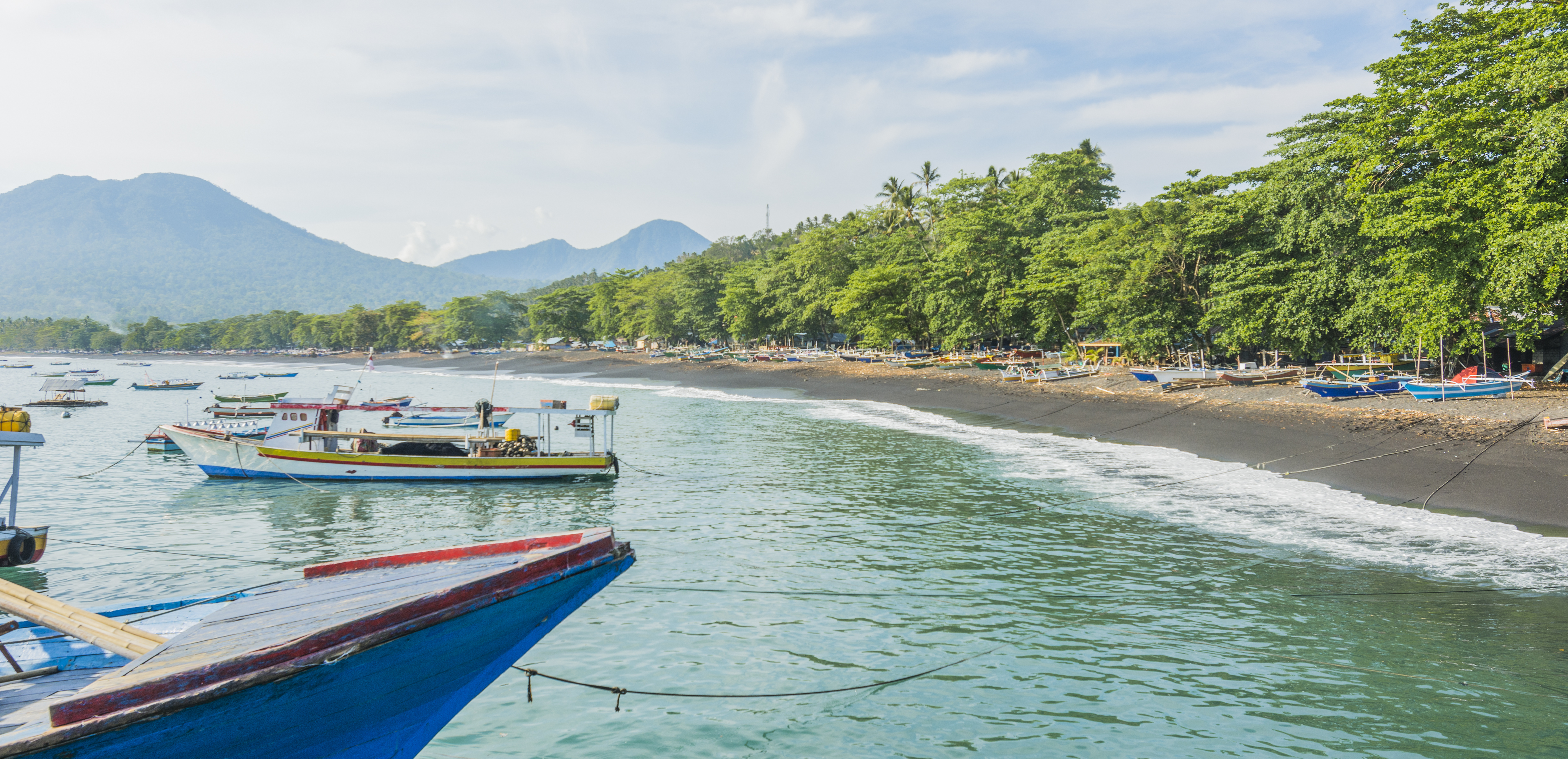
Getting There:
Fly to Manado, the capital of North Sulawesi province of Indonesia. There are no direct flights from India, but options are available via Singapore, Hong Kong, Kuala Lumpur and Jakarta. From Manado, a two-hour (approximately 60 km.) drive takes you to Tangkoko. Though it is a year-round destination, it is recommended to avoid the wet season, which is from October to April/May. The dry season is from June to September/early October. The season peaks in July/August and prices are high then. September to early October is the shoulder season – where one can take advantage of fewer number of tourists and a good climate.
Bucket list ideas:
- Trek through the jungle early morning for birding. Mornings are more rewarding than afternoons. Afternoon treks are however a must for the ‘big four’ sightings. Spectral tarsiers can be seen only at twilight.
- On a night when the sea is calm, a swim will allow for the sighting of bioluminescent zooplanktons, making for a lifetime experience.
- The Celebes sea beside Tangkoko is a hotspot for scuba diving.
- Lembeh island across the sea has numerous diving resorts. Lembeh is famous for muck diving – diving down to the volcanic, sandy ocean bottom to explore for unique creatures – mantis shrimp, ribbon eels, hairy frogfish, seahorses, and nudibranch, to name a few.
- Scuba enthusiasts should visit Bunaken island as the area has gorgeous coral reefs and notable underwater biodiversity wealth (Bunaken Marine National Park).
- Visit Minahasa highland in North Sulawesi for picturesque landscapes, volcanic colour-changing lakes, and walks around volcano craters. While there, do not forget to experience the traditions and cultures of the island.
Associate professors of Chemistry for almost two decades, Mita and Pinak Dutta are ardently passionate about travelling, wildlife, conservation and diving. While Mita documents her experiences with words, Pinak, an award-winning photographer, documents with his images


_1597406602.jpg)



 The tarsier is a species of small leaping primates found on various islands of Southeast Asia, belonging to the 45-million-year-old family Tarsiidae. The tarsiers of Southeast Asia are among the smallest – they measure between nine and 16 cm. long, with long tails about twice that length. They are quite unusual in appearance – resembling an intermediate form of lemurs and monkeys. Their most striking features are their large goggling eyes, measuring typically 1.5 cm., which are an evolutionary tactic for nocturnal survival due to their lack of a tapetum lucidum, a reflective layer behind the retina that nocturnal animals usually possess. The name tarsier is eponymous of their elongated tarsal region, in which their tibia and fibula bones are fused; this greatly enhances their leaping ability – they can jump 40 times their body length in a single leap! Tarsiers are currently divided into three genera and 11 species. The genus Tarsius, with nine species, is restricted to Sulawesi and nearby small islands of Indonesia. The other two tarsier genera are at present monotypic; one is from Philippines and the other from Borneo, Sumatra and nearby small islands. The spectral tarsier Tarsius spectrum residing in Tangkoko is a nocturnal, carnivorous predator that hunts for insects like katylids (long-horned grasshoppers), roaches and crickets using their highly sensitive eyes, mobile ears and grasping hands. They live in social groups made up of a mating pair and their offspring, usually inside the dark hollows of trees. Tarsiers are one of the most vulnerable victims of the illegal pet trade. Sadly, many individuals die soon after capture. The spectral tarsier population is decreasing and is marked as Vulnerable in the IUCN Red List.
The tarsier is a species of small leaping primates found on various islands of Southeast Asia, belonging to the 45-million-year-old family Tarsiidae. The tarsiers of Southeast Asia are among the smallest – they measure between nine and 16 cm. long, with long tails about twice that length. They are quite unusual in appearance – resembling an intermediate form of lemurs and monkeys. Their most striking features are their large goggling eyes, measuring typically 1.5 cm., which are an evolutionary tactic for nocturnal survival due to their lack of a tapetum lucidum, a reflective layer behind the retina that nocturnal animals usually possess. The name tarsier is eponymous of their elongated tarsal region, in which their tibia and fibula bones are fused; this greatly enhances their leaping ability – they can jump 40 times their body length in a single leap! Tarsiers are currently divided into three genera and 11 species. The genus Tarsius, with nine species, is restricted to Sulawesi and nearby small islands of Indonesia. The other two tarsier genera are at present monotypic; one is from Philippines and the other from Borneo, Sumatra and nearby small islands. The spectral tarsier Tarsius spectrum residing in Tangkoko is a nocturnal, carnivorous predator that hunts for insects like katylids (long-horned grasshoppers), roaches and crickets using their highly sensitive eyes, mobile ears and grasping hands. They live in social groups made up of a mating pair and their offspring, usually inside the dark hollows of trees. Tarsiers are one of the most vulnerable victims of the illegal pet trade. Sadly, many individuals die soon after capture. The spectral tarsier population is decreasing and is marked as Vulnerable in the IUCN Red List. 